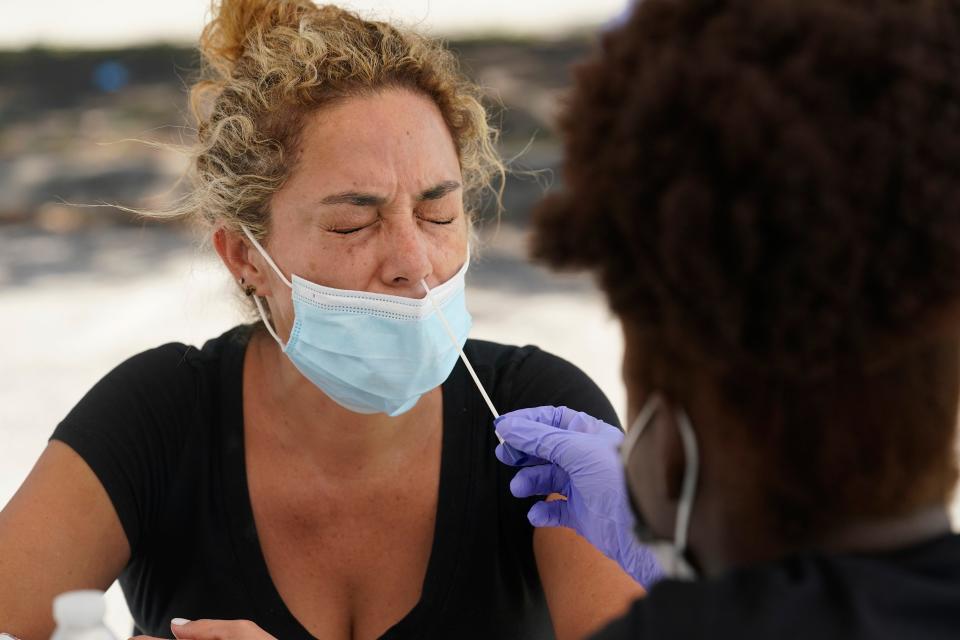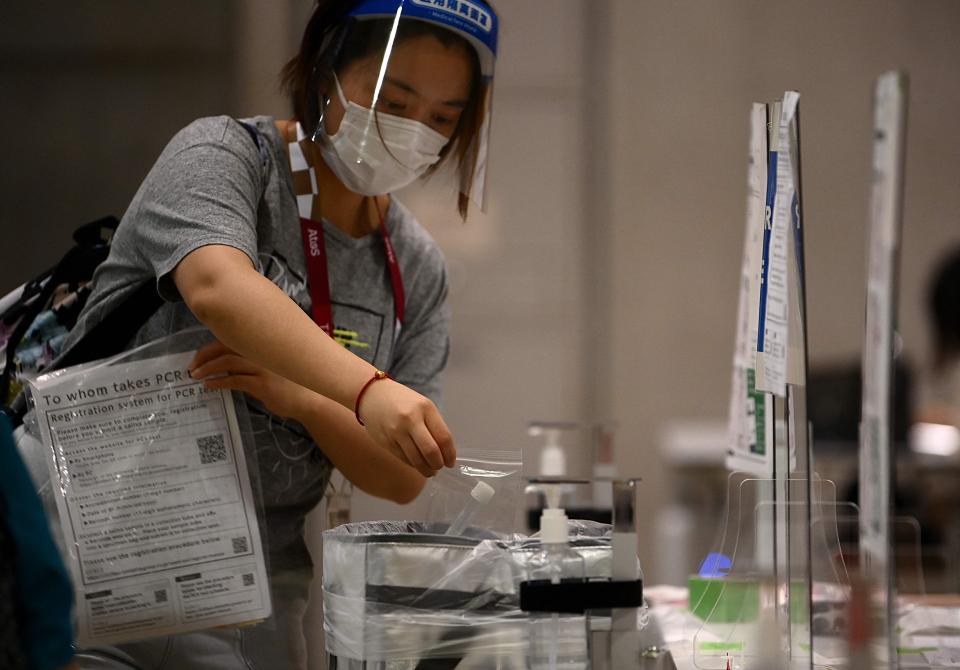Fact check: CDC test doesn't conflate COVID-19 virus with influenza
The claim: CDC test adds influenza cases to COVID-19 tally
As the delta variant surges across the country, social media users are reviving old claims that question the reliability of the COVID-19 case count.
The latest wave of misinformation surrounding the case totals stems from the U.S. Centers for Disease Control and Prevention’s announcement that it would withdraw its emergency use authorization request for a test meant to detect SARS-CoV-2, the virus that causes COVID-19, by the end of the year.
The alert encourages laboratories to use a test that can distinguish between SARS-CoV-2 and influenza.
Some social media posts pointed to that as proof the test could confuse the two viruses, inflating the number of COVID-19 cases with influenza, which was down significantly during the flu season. The U.S. has had more than 34 million cases of COVID-19 since the start of the pandemic, according to CDC.
Former Arkansas Gov. Mike Huckabee wrote in a July 26 Facebook post about the alert that the test could not differentiate whether someone is infected with COVID-19 or influenza.
He wrote that it was "sparking questions" about the inclusion of cases identified with the test in the tally of COVID-19 cases. Others claimed outright that influenza cases were added to the COVID-19 total.
Fact check: COVID-19 pandemic spurred record-low flu activity this season
Experts interviewed by USA TODAY said that is impossible, though, because the test the CDC will discontinue searches for a genetic makeup that is unique to SARS-CoV-2. It does not look for influenza’s genetic material.
“It’s technically impossible for that to happen,” said Dr. Petros Giannikopoulos, medical director of the Innovative Genomics Institute’s COVID-19 testing consortium.
Huckabee did not immediately respond to a request for comment.

Can the test confuse SARS-CoV-2 and influenza?
Experts interviewed by USA TODAY agreed that posts claiming the CDC’s test could confuse SARS-CoV-2 and influenza are wrong.
The test is called a real-time reverse-transcription polymerase chain reaction (RT-PCR), a type of test that has existed for decades and that the CDC adopted in the early days of the pandemic to detect SARS-CoV-2.
The U.S. Food and Drug Administration authorized the test for emergency use in February 2020.
More: How a 1960s discovery in Yellowstone made millions of COVID-19 PCR tests possible
Here’s how it works: Samples are taken via a nasal swab and sent to a lab. Viral RNA and DNA are separated at the lab, and the viral RNA is converted to DNA. The test then makes copies of the converted RNA until it reaches a threshold that matches the genetic makeup of SARS-CoV-2.
Because the test is reproducing the viral RNA, even small levels of virus can be amplified to detectable levels.
But key to the test are what are known as “primers,” Giannikopoulos said. Those are designed around the unique genetic makeup of the virus the test is seeking to find. In the case of the CDC’s test, that is SARS-CoV-2.
“The PCR tests are very precise and that’s why they are often held up as the gold standard for diagnosing SARS-CoV-2 as well as other diseases. That’s the beauty of it. It’s so precise,” said Gigi Gronvall, senior scholar at the Johns Hopkins Center for Health Security at the Bloomberg School of Public Health.
Giannikopoulos described the genetic sequences in the primers as a “barcode.” The test searches for the barcode that matches SARS-CoV-2, not influenza, so it would never confuse the genetic sequences as the posts claim.
“It’s not lions and tigers. It’s lions and fish,” said Dr. Alan Wells, medical director of the University of Pittsburgh Medical Center Clinical Laboratories. “The two viruses are very distinct.”
While the test the CDC will discontinue is set up only to search for the genetic material of SARS-CoV-2, others, referred to as “multiplex” tests, include additional primers for other viruses too, including influenza. That allows the test to search for both viruses and distinguish between the two.

Why is CDC discontinuing the real-time RT-PCR test?
The CDC issued its “laboratory alert” about its plans to discontinue the real-time RT-PCR test on July 21.
The CDC wants to encourage labs to start using tests that also check for influenza to conserve time and resources, Jasmine Reed, a CDC spokeswoman, said in an email. Other commercially available testing options that didn’t exist at the start of the pandemic now are available as well, she said.
Fact check: Post distorts WHO's COVID-19 PCR testing guidelines
“Although the CDC 2019 Novel Coronavirus (2019 nCoV) Real-Time RT-PCR Diagnostic Panel met an important unmet need when it was developed and deployed and has not demonstrated any performance issues, the demand for this test has declined with the emergence of other higher-throughput and multiplexed assays,” Reed said.
The FDA lists hundreds of tests for SARS-CoV-2 that have received emergency use authorizations. The CDC also has its own multiplex test that can detect both SARS-CoV-2 and influenza.
“If I’m the CDC I want to know what’s not just going on with SARS-CoV-2 but influenza,” Giannikopoulos said. “Why have people come in for two swabs when you can have them come in for one swab.”
Our rating: False
The claim that a CDC test adds influenza cases to the COVID-19 tally is FALSE, based on our research. The real-time RT-PCR test CDC intends to discontinue by the end of 2021 searches for the genetic makeup of SARS-CoV-2, which is different from that of the influenza virus. For that reason, experts told USA TODAY that a real-time RT-PCR test could not mistake SARS-CoV-2 for influenza. The CDC is encouraging the use of tests that search for both SARS-CoV-2 and influenza to conserve testing resources during flu season.
Our fact-check sources:
Jasmine Reed, Centers For Disease Control and Prevention spokeswoman, July 26, Email interview with USA TODAY
Gigi Gronvall, senior scholar at the Johns Hopkins Center for Health Security at the Bloomberg School of Public Health, July 27, Phone interview with USA TODAY
Dr. Alan Wells, medical director of the University of Pittsburgh Medical Center Clinical Laboratories, July 27, Phone interview with USA TODAY
Dr. Petros Giannikopoulos, medical director of the Innovative Genomics Institute’s COVID-19 testing consortium, July 26, Phone interview with USA TODAY
Innovative Genomics Institute, accessed July 27, About Us
Centers for Disease Control and Prevention, accessed July 27, COVID data tracker
U.S. Food and Drug Administration, accessed July 27, CDC 2019-Novel Coronavirus (2019-nCoV) Real-Time RT-PCR Diagnostic Panel instructions for use
Centers for Disease Control and Prevention, July 13, CDC’s Diagnostic Test for COVID-19 Only and Supplies
Emerging Infectious Diseases, May 26, Multiplex Real-Time Reverse Transcription PCR for Influenza A Virus, Influenza B Virus, and Severe Acute Respiratory Syndrome Coronavirus 2
Centers for Disease Control and Prevention, Aug. 5, 2020, CDC Diagnostic Tests for COVID-19
Centers for Disease Control and Prevention, July 21, Lab Alert: Changes to CDC RT-PCR for SARS-CoV-2 Testing
U.S. Food and Drug Administration, accessed July 27, Individual EUAs for Molecular Diagnostic Tests for SARS-CoV-2
FactCheck.org, July 26, Viral Posts Misrepresent CDC Announcement on COVID-19 PCR Test
Thank you for supporting our journalism. You can subscribe to our print edition, ad-free app or electronic newspaper replica here.
Our fact-check work is supported in part by a grant from Facebook.
This article originally appeared on USA TODAY: Fact check: CDC test doesn't conflate COVID-19 virus with influenza

 Yahoo Movies
Yahoo Movies 
